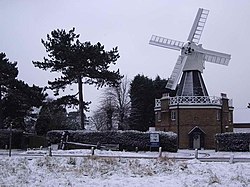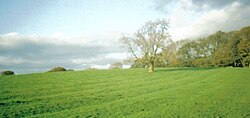Common land
Common land (a common) is land where local people have certain rights. For example, to allow their sheep to graze, to collect firewood, or to cut turf for fuel.[1]
Originally in mediaeval England the common was part of the manor. Although it was part of the estate owned by the lord of the manor, tenants had certain rights.
By extension, the term "commons" has come to be applied to other resources which a community has rights or access to. Today the term "common" is mainly used for the land over which the rights are exercised. A person who has a right to common land is a commoner.[2][3]
Today commons still exist in Great Britain and the United States, although their extent is much reduced from the millions of acres that existed in the 17th century.[4]
Common Land Media
Poohsticks Bridge in Ashdown Forest, an area of common land
Conjectural map of a mediaeval English manor. The part allocated to "common pasture" is shown in the north-east section, shaded green.
View of the Scafell massif from Yewbarrow, Wasdale, Cumbria. In the valley bottom are older enclosures and higher up on the fell-side are later enclosures on poorer land with substantial walls following boundary lines regardless of terrain. Above those is the unenclosed common land.
The windmill on Wimbledon Common
Rig and furrow marks at Buchans Field, Wester Kittochside
Cambridge Common, c. 1808–9, with Harvard College at left and Christ Church at right
Wakefield, Massachusetts, town common showing bandstand/gazebo at right and lake at left
Related pages
References
- ↑ Natural England Archived 2010-01-28 at the Wayback Machine.
- ↑ Anon. "Commoner". Farlex Inc. Retrieved 20 April 2012.
- ↑ Neeson J.M. 1993. Commoners: common right, enclosure and social change in England, 1700-1820. Cambridge: Cambridge University Press. ISBN 0-521-56774-2
- ↑ De Moor, Martina; Shaw-Taylor, Leigh; Warde, Paul (eds) 2002. The management of common land in North West Europe, c. 1500-1850. Turnhout, Belgium: Brepols. ISBN 978-2-503-51273-0









